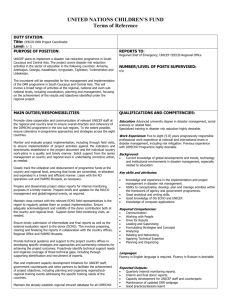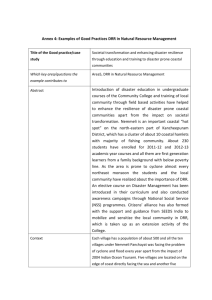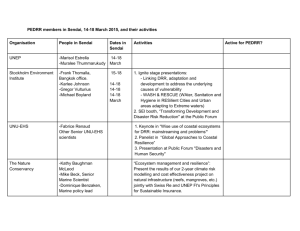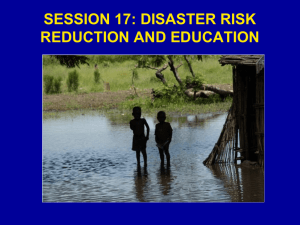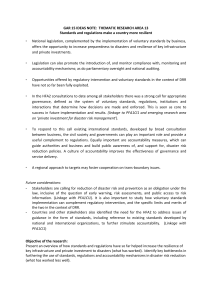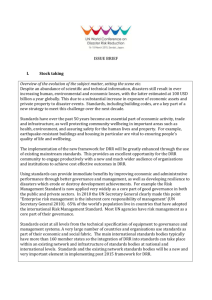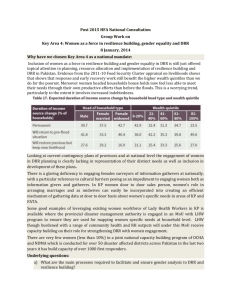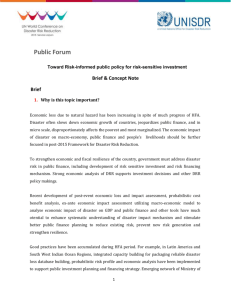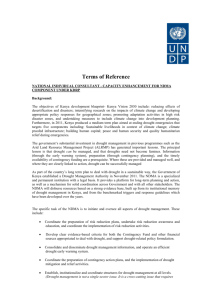View report - PreventionWeb
advertisement
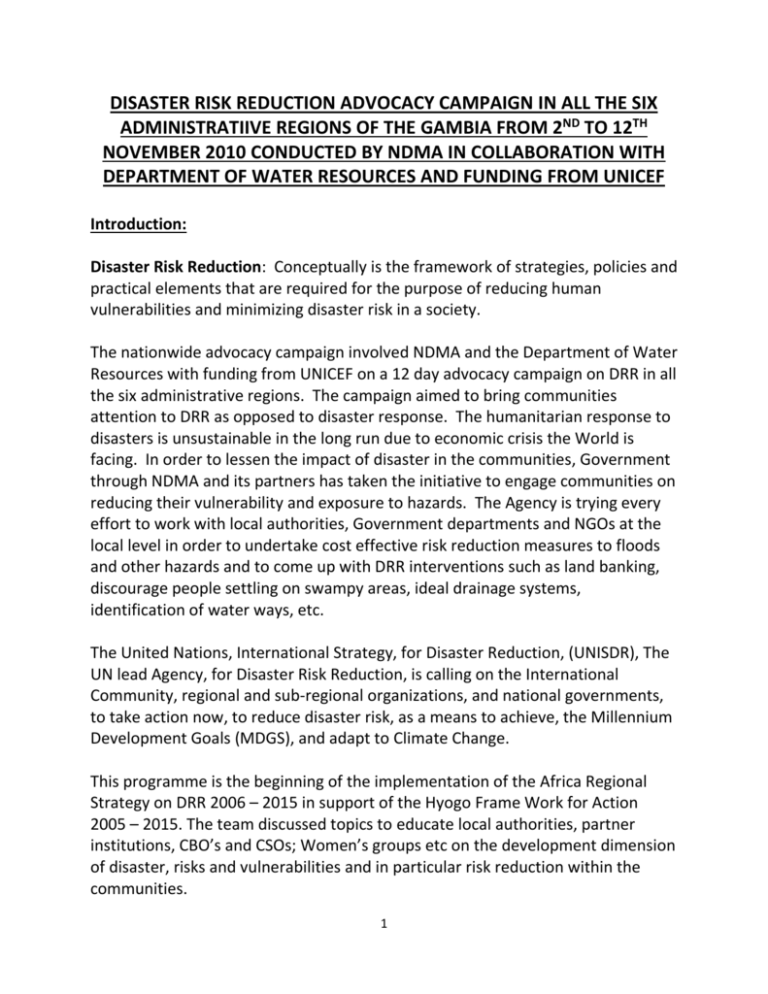
DISASTER RISK REDUCTION ADVOCACY CAMPAIGN IN ALL THE SIX ADMINISTRATIIVE REGIONS OF THE GAMBIA FROM 2ND TO 12TH NOVEMBER 2010 CONDUCTED BY NDMA IN COLLABORATION WITH DEPARTMENT OF WATER RESOURCES AND FUNDING FROM UNICEF Introduction: Disaster Risk Reduction: Conceptually is the framework of strategies, policies and practical elements that are required for the purpose of reducing human vulnerabilities and minimizing disaster risk in a society. The nationwide advocacy campaign involved NDMA and the Department of Water Resources with funding from UNICEF on a 12 day advocacy campaign on DRR in all the six administrative regions. The campaign aimed to bring communities attention to DRR as opposed to disaster response. The humanitarian response to disasters is unsustainable in the long run due to economic crisis the World is facing. In order to lessen the impact of disaster in the communities, Government through NDMA and its partners has taken the initiative to engage communities on reducing their vulnerability and exposure to hazards. The Agency is trying every effort to work with local authorities, Government departments and NGOs at the local level in order to undertake cost effective risk reduction measures to floods and other hazards and to come up with DRR interventions such as land banking, discourage people settling on swampy areas, ideal drainage systems, identification of water ways, etc. The United Nations, International Strategy, for Disaster Reduction, (UNISDR), The UN lead Agency, for Disaster Risk Reduction, is calling on the International Community, regional and sub-regional organizations, and national governments, to take action now, to reduce disaster risk, as a means to achieve, the Millennium Development Goals (MDGS), and adapt to Climate Change. This programme is the beginning of the implementation of the Africa Regional Strategy on DRR 2006 – 2015 in support of the Hyogo Frame Work for Action 2005 – 2015. The team discussed topics to educate local authorities, partner institutions, CBO’s and CSOs; Women’s groups etc on the development dimension of disaster, risks and vulnerabilities and in particular risk reduction within the communities. 1 Objective/purpose To avoid (prevention) or to limit (mitigation and preparedness) the adverse impacts of hazard events. DRR should therefore be addressed as a cross-cutting and development issue Invest in and maintain critical infrastructure, that reduces risks, such as flood and drainage system and make adjustments where needed, to cope with climate change. Apply and enforce, realistic, risk – compliant building regulations, and land use planning principles, and where feasible, identify safe land, for low income citizens, and develop upgrading, of informal settlements. Ensure that education programmes, and training, on disaster risk reduction, are in place, in schools and local communities. Ensure that the needs of affected communities are placed, at the centre of reconstruction, of damaged social infrastructure, with the full engagement, of the communities affected. Lessons Learnt: The visit was participatory and interactive to adequately strategise on medium to long term interventions and to address some of the constraints identified which could hinder the smooth implementation of DRR interventions. It will also enable the Agency to enhance its partnership drive to address some of the issues raised. Recommendations: To provide funds for more sensitization on DRR at community levels Provide funds for the development of integrated regional work plans Engage the private sector on the economics of DRR The communities to be at the fore front of any DRR interventions 2 The UNCT to fully incorporate DRR into their Country Cooperation Programmes; CCA (Common Country Assessment) and UNDAF (United Nation Development Assistance Framework) Integrate DRR into National development policies and programmes, sectoral policies and programmes, PRSP II and PAGE Conclusion: Executive Director cited the President and Vice President’s field visits to the disaster prone areas which shows the high political commitment of the Government and concern for the citizens of the Gambia. The Government is trying every effort to help the needy and the poor. He extended appreciation to the Regional Governors, Mayors and local authorities for their effective coordination, leadership and swift response at the decentralized level. Governors and their committees respectively, gave special thanks and appreciation to H.E The President Sheikh Professor Dr. Alhagie Yahya A.J.J. Jammeh and the Vice President Ajaratou Isatou Njie Saidy, UNICEF, Department of Water Resources for the effective advocacy campaign to make their cities, towns, and communities, resilient by putting in place the needed organization, and coordination, to understand and reduce, disaster risk, based on the participation of citizen groups, and civil society. Build local strategic alliances. Ensure that all Departments understand their role in disaster reduction, and preparedness, including during Emergency situations. 3 Issues discussed PROBLEMS Flood Wind Storm Fire Out Breaks (Domestic and forest fires) Poor Waste Management/ Indiscriminate dumping Sand/Gravel Mining CAUSES Lack of proper drainage system, poor settlements, poor building planning, sand mining etc EFFECTS Structural collapse, rice fields submerged, loss of livestock and human lives, disease outbreak, poor sanitation, displacement, property loss, skin problems etc Deforestation, inadequate Soil erosion, structural conservation practices, collapse, loss of lives and poor settlement, poor property, food insecurity, building plans etc soil infertility etc Hunting, smoking, wild Loss of live and property, bee keeping, electrical environmental connection/gas, over degradation, food loading of appliances etc insecurity and loss of animals etc Inadequate dumping sites, Flooding, pollution, indiscriminate dumping of disease, contamination of wastes, Inadequate soil and water etc resources, Attitudinal change Mined areas never filled Breeding place for back after use etc dangerous reptiles, criminal hideout, illegal 4 SOLUTIONS Proper/ adequate drainage system, land banking, capacity building, settlement plans, advocacy etc Intensive forestation, advocacy, enforcement of Forest Act, establish more community forests Provide fire belts, advocacy, create awareness, capacity building on usage and control of fire out break Provision of waste management industry, integrated waste management system and resources Adherence to sand mining rules, back fill when used Settlement Settling on waterways Patterns/topography of the /swampy areas, poor area constructions etc Infrastructural development Contaminated drinking water settlement such as Kotu quarry etc Overcrowding, flooding, disease outbreak, etc Proper settlement planning, enforcement of building codes and land use planning, land banking etc Inadequate mapping Flooding, structural Adequate feasibility studies during road and drainage collapse, etc before project constructions etc implementation and introduction of EIA on community projects. Inclusion of DRR into the EIA process Over flow of wells due to Disease outbreak, skin Provide chlorine tablets the oozing of groundwater infection, warms, diarrhea, (water chlorination), and surface flooding etc Cholera etc adequate health & hygiene promotion and the provision of adequate sanitary materials. 5



